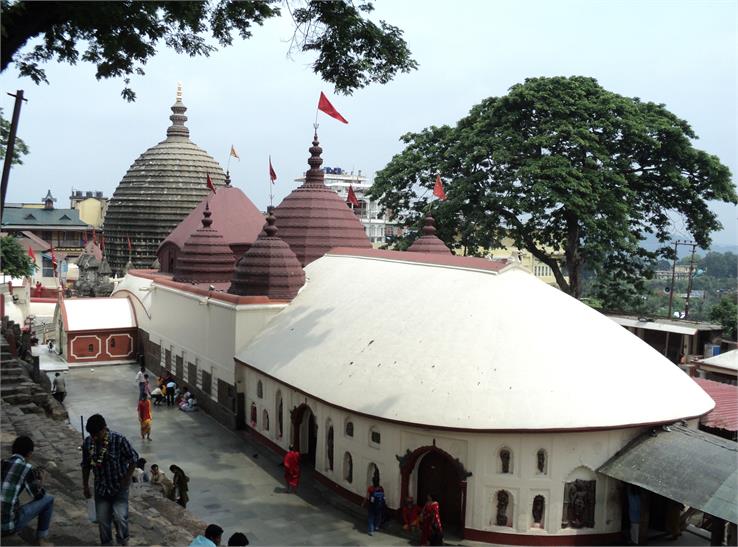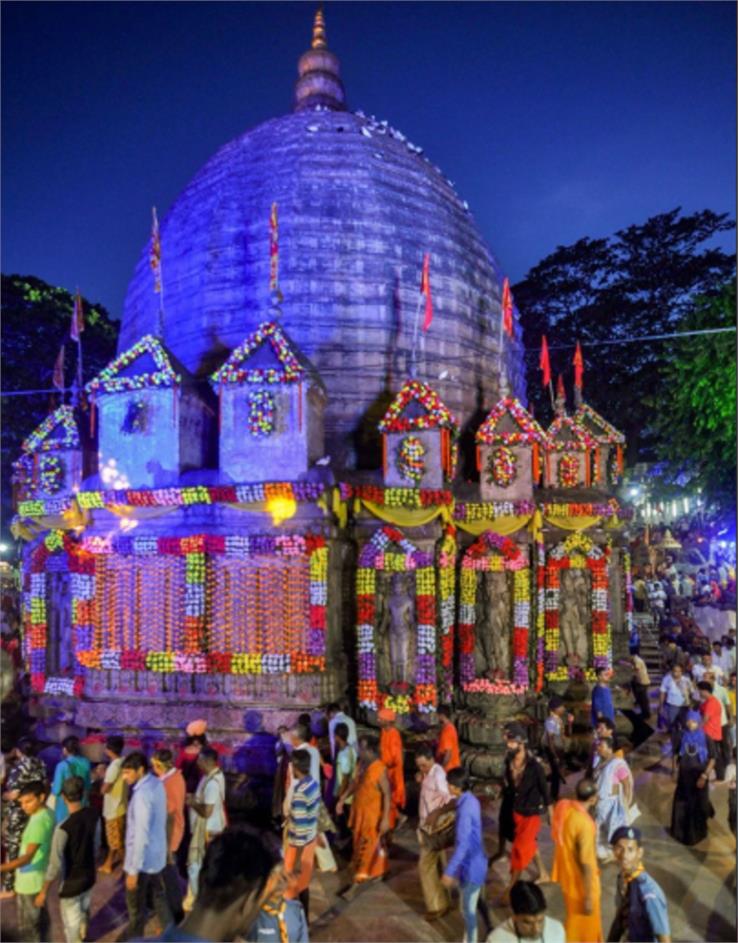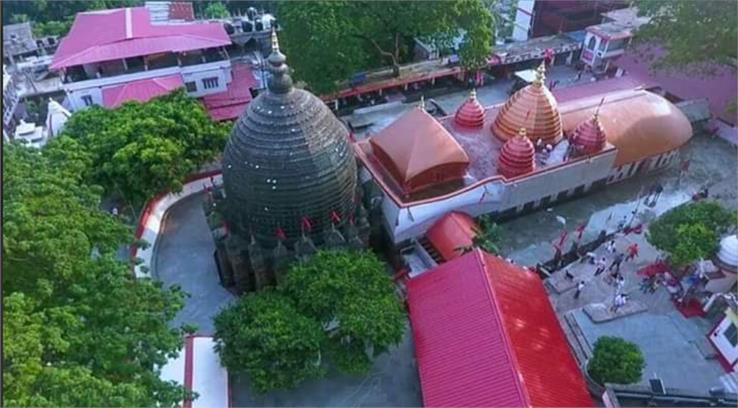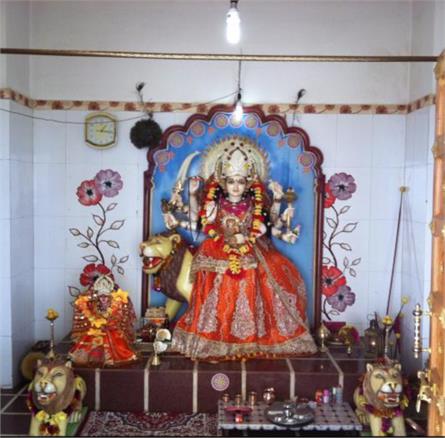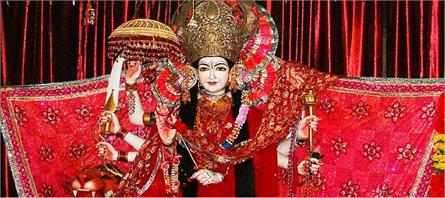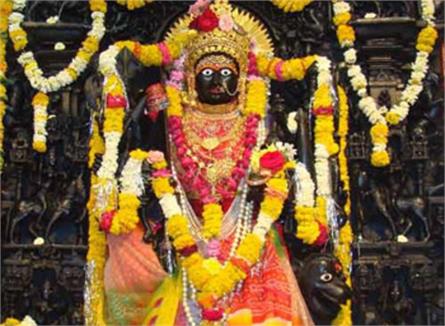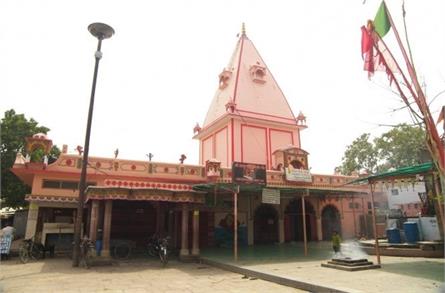Kamakhya Temple - History, Timings, Infrastructure & How to reach
The renowned Goddess of Desire, the temple of Maa Kamakhya or Kameswari is considered most sacred and oldest among the 51 Shakti Peethas in India. It is located in the heart of Nilachal Hill situated in the western part of the capital city Guwahati in the Assam state of North East India. It is the center of widely practiced vigorous “Tantrik Shaktism” cult in India. In fact, it is believed that Kamakhya Temple is the origin of Black Magic. The holy place is also popular by the names of Kamrup-Kamakhya temple and Kamakhya Devalaya.
It is believed that Goddess Sati's womb part fell here hence the sacred place is a symbol of women power and fertility.
Kamakhya temple is located in the kamakhya Temple Complex with other ten temples dedicated to the Mahavidyas of Shaktism namely Bhuvaneshwari, Bhairavi, Bagalamukhi, Chhinnamasta, Dhumavati, Kali, Kamalatmika, Matangi, Sodashi, and Tara. Among these, deities of Tripurasundari, Matangi, and Kamala reside inside the main temple while the other seven dwell in their individual temples.
Also Read: Shikari Devi The Roofless Temple Full of Marvellous Secrets
What history says?
It is to be believed that the origin of the temple had pre-Aryan or tribal traits, while religious literature explains that it was erected by Kamdeva who regained his beauty. It was believed to be a massive structure, much bigger than the present one. Nonetheless, the upper portion of the temple was completely destroyed owing to some unknown reasons. For a long duration, the temple lost its significance because of the rise of Shaivism among the rulers during the Pragjyotisha Kingdom.
The temple had come into prominence at the time of the rule of King Naraka who was the first supreme ruler of the Brahmaputra Valley. However, there is no written or evidential reference describing the same from the successors of Naraka. Hence, the history of the temple is unclear until the rise of the Koch Kingdom during the mid-16th Century AD.
Further, some researchers have concluded that a beautiful temple of Goddess Kamakhya was built on the Nilachal Hill during 500 CE. But later, the upper part of the original temple was demolished due to the natural calamities. Besides, the lower portion of the temple was gradually buried.
There are different observations made on the restoration of the temple during the medieval period. At the time of around 1553-54 AD, the Koch King Biswa Singh reconstructed the temple. Subsequently, a Muslim invader from Gaur had destroyed the shrine. However, many scholars do not believe in this story and relate the cause of destruction to some natural calamity. The successor of the Koch dynasty, the great king Nara Narayana who visited this place with his brother Chilarai found it in complete ruins. He then refurbished the temple during 1565 AD and gave royal patronage.
During the early 17th century, a new phase of the Assam state government came into existence. The Ahom Kingdom was established as the paramount power of the Brahmaputra valley at this time. It was recorded that the Koch structure was further developed by the rulers of the Ahom kingdom. There are many stone inscriptions and copper plates that confirm the involvement of the Ahom Kings.
The great earthquake of 1897 A.D. damaged the main temple to an extent and also damaged the domes of some other temples of Kamakhya. The royal court of Koch Bihar came to the rescue and donated a hefty amount for repairing. Restoration of the temple was done during various phases in later periods as well.
The Assam earthquake of 1897 damaged the infrastructure of the temple and also ruined the domes of other temples in the complex. The royal court of Koch Bihar came to the rescue and offered a hefty amount for the renovation of the temple facility. The temple has also been restored during several phases in later times.
The history of Kamakhya Temple has always been in talks of the town, but many royal patrons who contributed to the great holy place will be eternally remembered.
Also Read: The Divine Power of 12 Jyotirlinga
Legends of the Temple
- According to folklore, Kamdev, husband to Rati, was reduced to ashes by the fire ejected out the third eye of Lord Shiva. Later, Rati requested Lord Shiva to revive Kamdev because he was told to do so by the Gods. Lord Shiva, being an embodiment of love, imparted life to Kamdev. Although the beauty of Kamdev disappeared, so the couple offered prayers to Lord Shiva to reinstate Kamdev into his original self. Later, the almighty advised Kamdev to find the sacred Yoni Mudra hidden in Nilachal Hills and worship Devi in order to regain his beauty. Kamdeva devoted himself in the prayers for Shakti and convinced her successfully. He gained his lost beauty with the blessings of Devi Shakti. He then established a magnificent temple over the Yoni Mudra with the assistance from Vishakarma. This is why the holy place is also known as Kamarupa which denotes Kam + Rupa (Kamdeva who regains his beauty).
- Kalika Puran is one of the most sacred texts for the “Shakta” sect and presents a mythical story about the origin of the temple. It was written around the 9th century. As mentioned in Kalika Purana, Nilachala is the place where Sati used to retire with Shiva, i.e., Kama. The Kalika Puran embraces many details about Kamakhya Temple.
- Further, the Yogini Tantra, which was written around the 16th century contradicts the origin of Kamakhya given in Kalika Purana. It describes the emergence of Kamakhya with the goddess Kali and emphasizes the creative symbolism of the yoni.
- Moreover, the Koch Bihar royal family was prohibited by Kamakhya Devi herself from offering prayers at the temple as per the legend. As a matter of fact, the descendants of that family still do not dare to even look upward towards the Kamakhya hill while passing through due to the curse. The temple witnessed a lot of adversity without the support of the Koch Bihar royal family.
Infrastructure

The present Kamakhya Temple was rebuilt in 1565 AD from the ruins of a stone temple of 11th-12th century AD. Located on the hill called Nilachala or Blue Hill, it had been sculpted out of an exceptional mixture of two different styles, Saracenic or Mughal and the traditional nagara or North Indian. However, it has been named as the Nilachala Style of Architecture due to its unusual combination.
This architecture-type became a dominating pattern for the infrastructure of temples through royal patronage in the following times of Assam.
Kamakhya is the only temple in Assam with fully developed ground-plan and is very unique in its features. It has five chambers, garbhagriha (sanctuary), antarala (vestibule), jagamohan (principal chamber), bhogmandir or pancharatna (ritual chamber), and natmandir (opera hall). The natmandir is used for performing traditional dance and music-related with sukti temples which was added to the complex by the Ahom king Rajeswar Singha in 1759 AD. Notably, the superstructure of each chamber has different architectural features. There is a modified Saracenic dome in the main temple, while antarala contains a two-roofed design just like the old-style thatched cottages. The bhogmandir consists of five domes and the natmandir possess a shell-roof with apsidal end similar to most prayer halls in Assam.
The garbhagriha of the other temples in the Kamakhya complex follow the same structure - a yoni-shaped stone, filled with water and below ground level. The current structure has a beehive-like shikhara characteristic of lower Assam with delightful sculptured panels and images of Ganesha and other Hindu gods and goddesses on the outside.
We have already mentioned about the dasamahavidya or ten aspects of Devi Kamakhya. Apart from these deities, there are five Shiva temples, one Vishnu temple, and a few shrines and temples of other gods. It has been trusted that the garbhagriha or the sanctum sanctorum of the temple embraces the mythical yoni of the Hindu goddess Shakti.
Curiously enough, the Brahmaputra river turns red in the month of Ashad (June) every year. It is considered that the goddess menstruates during this time.
More Information about the Temple
Schedule of the temple
| S. No. | Events of the day | Timings |
| 1 | Snana of the Pithasthan | 5:30 AM |
| 2 | Nitya Puja | 6:00 AM |
| 3 | Temple door open for devotees | 8:00 AM |
| 4 | Temple door closed for cooked offerings to the goddess followed by distribution among the devotees | 1:00 PM |
| 5 | Temple door reopens for the devotees | 2:30 PM |
| 6 | Closing of the temple door at sunset | 5:15 PM |
| 7 | Aarti of Goddess | 7:30 PM |
Source: www.maakamakhya.org
Temple Timings
There are no specific visiting hours for tourists and pilgrims. The temple remains open from 5:30 in the morning to 10:00 in the night. These timings get extended on special occasions.
Special Occasions
The Kamakhya Temple which glorifies the womanhood celebrates ample occasions and the major festivals are:
Durga Puja
Of course, Durga Puja is one of the major festivals of Kamakhya which brings festive vibes and enthusiasm all around the place. With unique celebrations, it is observed for the fortnight (Paksha) and starts with Krishna Navami and ends with Sukla Navami of Ashwina. It is also popular with the name of Pakhua Puja.
Ambubachi Mela

Ambubachi Mela is the biggest fair held in the North East of India. Ambubachi is a combination of two words, ‘Ambu’ (water) and ‘Bachi’ (flowing) and the celebration honors the yearly menstruation course of goddess Kamakhya. It is held during the monsoon season in the month of ‘Ashadha’ according to the Assamese/Bengali calendar. It is also locally known as Amoti or Ameti. Ambubachi has an entrenched relation with ancient agricultural theory in which Mother Earth is compared to a fertile woman.
Kumari Puja
The Kumari Puja represents the worship of a young girl who is considered as a manifestation of the Goddess Kamakhya. According to Hindu mythology, the goddess surely exists in the virgin. The reverence to female children as goddesses is a venerable custom of India. The young girl is beautifully decorated with a new red sari, sindoor, garlands, jewelry, bindi, etc. and devotees take blessings from her. The maiden epitomizes the source of the powers that regulate stability, creation, and destruction. She is the early symbol of womanhood or nature.
Deodhani or Devadhwani Mela (Manasa Puja)
On the onset of Shravana Sankranti day, Manasa Puja is held for three days in Natmandir of the temple. Deodhani Nritya, a shamanistic dance form is performed according to the rituals by those who represent the spiritual power of a god or goddess. They are called Deodhas, Ghora, or Joki by local peoples. It is very popular among the devotees, thousands of people visit the temple to witness the Deodhanis perform during the Manasa Puja.
Others places to visit around
One of the sacred places in India, Kamakhya Temple premises itself boasts many other temples that should be explored during the visit. The capital city, Guwahati, has other numerous places to impress its travelers. Some of them are:
- Umananda Mandir
- Urvashi Kunda
- Ashwakranta Temple
- Basistha Ashram
- Nabagraha Mandir
- Guwahati Planetarium
- Assam State Museum
- Assam State Zoo cum Botanical Garden
- Maa Chandika Temple
- Dirgeshwari Mandir
How to reach
By Air
The major airport in all of North East India, Lokpriya Gopinath Bordoloi International Airport is the nearest as it is present in Guwahati only. Hence it is also called Guwahati International Airport. The airport is well connected with all the major cities in India. It is just about 20 km away from the main temple complex. Book a taxi/cab or board a bus to reach your destination.
By Train
Kamakhya Station is the second-largest station in the city and is nearest to Kamakhya Temple. It is just approximately 6 km away from the temple. Guwahati Station is also a major railway station of the city which is located at a distance of about 10 km. Guwahati is well connected with all the major cities of the country through rails. Book a taxi/cab or board a bus to reach your destination.
By Road
The city of Guwahati is well-connected with the adjoining cities and states through roads and highways. State or private bus services are easily accessible and regular to reach the desired location. The three nodal points of ISBT Guwahati, Paltan Bazar, and Adabari provide bus services to towns and cities in Assam and connecting states.
